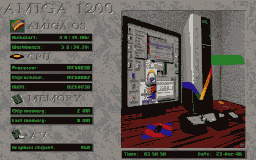
I have a lot of stuff to cover, so let's get to it. As usual, the Amiga programmers out there keep cranking out new code. I'm going to look at some major new version of popular programs.

|
|
| Figure 1:Syspic in Action |
|---|
Syspic is a program that can liven up your bland Amiga boot sequence.
Syspic can display IFF pictures, play sound samples and music mods, and
can also display information about your Amiga, such as OS version,
processor, time and date, etc. Syspic has a very nice random file
selection feature, so you can display a different picture with every
boot. You can also tell Syspic which screen mode to open on, very nice
for SVGA or Multisync monitors. See Figure 1 for a screen shot of
Syspic at work.
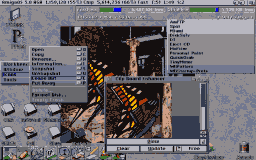
|
|
| Figure 2:NewIcons, CBE, Magic Menu |
|---|
NewIcons, originally by Nicola Salmoria, has been taken over by Eric Sauvageau and Phil Vedovatti. Version 3, which is now a commodity, has some nifty features, including the ability to turn off the borders on icons, as well as make tranparent areas in icons. A new preference program is also included. Some other new features include support for graphic boards, The new includes DefIcons with an expanded brainfile. DefIcons displays an icon based on the file type, for files with no icons. The new brainfile includes new file types like PNG and LZX. If you like the original icons that come with New Icons, be sure and check out Phil Vedovatti's Aesicons, a New Icons package, now up to release 9, Phil has created a ton of new icons to show off New Icons.
Magic Menu is one of the all time classic Amiga upgrades. This utility enhances the Amiga's menu system with Pop up, 3D style menus. Originally coded by Martin Korndörfer development is being continued by Olaf Barthel, with artwork by Mario Cattaneo. Version 2.15 features a more modern look, with graphic representation of keyboard shortcuts, checkmnarks, separator bars, and drop shadows.
Check out Figure 2 for a screenshot of my Workbench, using NewIcons v3 and Magic Menus.
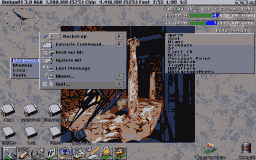
|
|
| Figure 3:Picture Menu |
|---|
Picture Menu, by Pawel Pijanowski is another program to spruce up your Workbench menus. Version 2, features redone graphics, included animated menu graphics. If you happen to own a color font editor, such as Cloanto's Professional Font Maker, you can create your own images for Picture Menu. Note that Picture Menu does not work with Tools Daemon, which adds new menus to the Workbench menustrip, or Rekeyit, which lets you define your own keyboard shortcuts. Picture Menu does work with earlier version of Magic Menu (such as 1.29), but may interfere with the new 2.15 version. See Figure 3 for an example of Picture Menu.
In a previous episode of Amazing Computing, I covered a new picture
datatype with support for 24 bit images. This new picture datatype, now
at release 43.757 is still in its beta testing stage, but the author has
eliminated the "expiration date" code. In earlier releases, this would
cause the datatypes to quit working on a certain date, which cause a lot
of confusion for people. On the other hand, the author has dropped
support for AGA, concentrating on Cybergrafx support. The datatype
still works on an AGA machine, if you have the earlier CyberNG library,
but no new features or bug fixes will be added for AGA.
akJFIF43x.lha
akPNG43x.lha
akGIF43x.lha
Andreas Ralph Kleinert
Shareware
In other datatype news, Andreas Ralph Kleinert has released new datatypes for PNG, GIF and JPEG images, which support 24 bit picture datatype. The PNG and JPG datatype have several options for display hi color images, including HAM, and dithering.
The following are a few goodies I either missed or was unable to try before. Up till now I have been using a venerable old CBM2002 monitor, so I haven't had much truck with mode promotion. Since I can now borrow my PC's SVGA monitor, I have found that the mode promotion facilities of WB 3.0 leave something to be desired. Particularly with a monitor that cannot display the NTSC or PAL 15 KHz modes, some way of enforcing particular screen modes for programs is sorely needed. There are several programs to do this- the two I am familiar with are ModePro and NewMode.
ModePro is a full featured Promotion utility. You have many options for delaing with mode promotion. You can select specific programs, screen names, or monitor modes that you want promoted. See Figure 4 for the ModePro prefs.
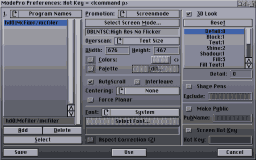
|
|
| Figure 4:ModePro preferences |
|---|
NewMode is also a thorough solution to mode promotion. NewMode can
promote a particualr group of programs, and then be set to get out of
the way. You can create a list of programs you want promoted, and then
NewMode will ignore other programs, quitely promoting only those
programs. See Figure 5 for the NewMode Prefs.
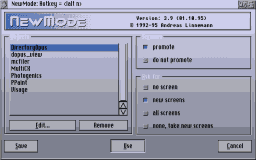
|
|
| Figure 5: Newmode Prefs |
|---|
The Amiga's clipboard is very handy, but unfortunately, although there
are up to 256 separate clip board units, usually you only can access
one, which means, you can only copy one item at a time to the clipboard,
and it overwrites any previous item stored there. Clipboard Enhancer
(CBE) is a very handy utility which extends the capabilities of the
Amiga's clipboard. CBE adds a history, so you can copy items, text
pictures, whatever, and they won't be overwritten. It also features a
browser, so you can look over the items you have stored in the
clipboard. If you have OS 3.0+, you can use datatypes to read text
and/or view pictures right in the CBE window. See Figure 6 for the CBE
Clipboard browser. (Thanks to Donald Feldbruegge for reminding me about
this handy program!)
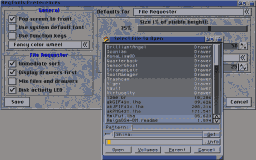
|
|
| Figure 6:Clipboard Enhancer, TinyMeter |
|---|
The ASL filerequester Commodore added with the 2.0+ OS was certainly an improvement over the mish mash of file requesters (when you even had a file requester!) under earlier versions of Workbench, but it does have a few quirks. One of my least favorite quirk is putting the directories at the bottom of the requester, after the files. There have been a number of programs offering enhancements to the Amiga's requesters, and one of the more popular is ReqTools. The original version was by Nico Francois, a name familiar to readers of theseries, and Amiga users in general. Lately the project has been taken over by Magnus Holmgren, and is now at version 2.7. ReqTools features the following requesters: a query requester, a string requester, a number requester, a file requester, a font requester, a palette requester, a volume requester and a screenmode requester. ReqTools includes RTPatch, by Dave Jones, so all your system requesters can automatically use the new Requesters. See Figure 6 for the ReqTools prefs program, and a resultant file requester. In addition to the users package, programmers can get the developer package, and add these features easily to their own programs.
Tiny meter, by Tinic Urou, could be thought of as a memory meter on steroids. In addition to displaying time and date, graphical memory, storage and CPU usage, it can also launch programs. See the right hand side of Figure 2 and 3 for different configurations of TinyMeter in action.
If you use an image for your window or workbench backdrop, you may find your favorite font is a little hard to read. Enter Daniel Nyberg's OutlineFont. This little patch creates an outline around each character. You can use a contrasting color to make the text stand out against a busy backdrop. Again, see Figure 6 for this utility in action.
In Episode 5, I mentioned I would like the New Amiga OS to avoid memory fragmentation. Well, while we all wait for the next generation of Amiga OS, here is a little util that could help stave off memory fragmentation on your current Amiga. Eric Sauvageau's (a familiar name!) LowFrag helps avoid fragmentation by using the memory pool system of the Amiga, and Exec's memory allowcation flag MEMF_REVERSE. Basically, little chunks of memory are allocated from one end of the memory pool, and big chunks are allocated from the other end. This prevents large areas of memory from being chopped up when little bits of memory are used.
Well, that's it for this episode.
 |
||||||
|